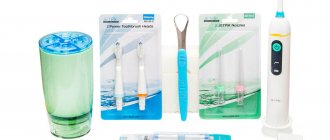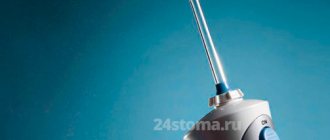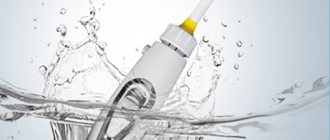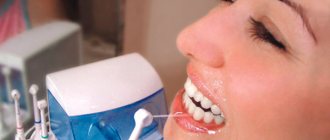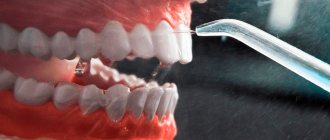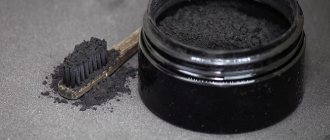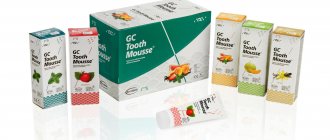Good oral hygiene is extremely important not only to maintain an aesthetically attractive appearance, but also to maintain the healthy functioning of the body as a whole. Currently, there are many functionally useful devices for hygienic treatment of the oral cavity. One such device is an irrigator.
In this article we will try to tell you in detail about how to properly use an irrigator to clean your teeth and how often you can use an oral irrigator .
Why do you need an irrigator and how does it work?
An irrigator is essentially a device that treats the oral cavity using a focused jet of water supplied under high pressure. The enhancing effect is the pulsating mode of liquid supply. As a result of this treatment, full-scale removal of contaminants occurs both from the surface of the teeth and gums, and from the interdental spaces.
In connection with the popularization of irrigators, consumers have a number of questions, the most pressing of which are: how to properly use an irrigator for cleaning teeth and how often can you use a dental irrigator ?
At what age can children use an irrigator? In order to answer these and many other questions related to the use of this relatively new device for us, it is necessary to consider in more detail some of the nuances.
Who needs an irrigator and why?
Dentists recommend using this device regularly to:
- better hygiene to prevent caries and other diseases;
- care of orthodontic structures (braces, veneers, dentures, bridges);
- treatment of chronic forms of gingivitis and periodontitis.
People cannot do without the device:
- suffering from bad breath;
- having a non-standard arrangement of the dentition;
- patients with diabetes mellitus.
The device can be used for both preventive and therapeutic purposes. It cleans teeth, interdental spaces, gum pockets and other hard-to-reach places from germs, plaque and food debris more thoroughly than other devices. Thereby reducing the likelihood of caries and other diseases and eliminating unpleasant odors.
Is it necessary to use an irrigator with installed braces, veneers, bridges and other structures? The answer is yes. The fact is that all orthodontic devices for correcting bites and solving other problems “like a magnet” collect microbes and food particles and, in the absence of proper care, can cause an exacerbation of existing diseases. In this case, you should take very good care of your oral hygiene. This is only possible with daily use.
This device is especially relevant for people suffering from diabetes. Unfortunately, with this disease, the blood circulation of the gums is impaired, and, as a result, periodontitis occurs. Regular massage performed with a pulsating jet improves their blood supply, maintaining dental health. This is also important for people who do not suffer from this pathology.
The irrigator is also used to treat certain diseases. To do this, instead of ordinary boiled water, use a special medical solution that has the required medicinal properties. For example, furatsilin, chlorhexidine, diluted rinses or various herbal decoctions.
But each method has contraindications. For advice on the use of a medicinal drug, you can contact dental specialists.
Whether you need a dental and oral irrigator at home is up to you, but remember that its effectiveness is achieved through regular use. In addition, by purchasing such a device for home use, you significantly save on the cost of dental procedures. And if other family members also use the device, then your savings will be two, three or even four times greater. In addition, any disease is easier to prevent than to treat later.
Indications for use of the irrigator
- Prevention of caries. Due to the fact that the effect of the irrigator extends to the most inaccessible areas of the oral cavity, it becomes a good prevention of many dental diseases, the main and most common of which is caries. The irrigator is able to clean both the surface of the front teeth and wisdom teeth, which are the most inaccessible, and therefore are recognized as the most vulnerable dental units;
- Prevention of gum disease. A focused and dense stream supplied by the irrigator has a massaging effect on the surface of the gums, which in turn serves as a good prevention of many diseases, including bleeding;
- Care of implantation, prosthetics and braces systems. The irrigator is capable of efficiently and quickly processing both the surface of prosthetic elements and the cavities hidden behind them;
- Prevention of gingivitis. A massaging jet of water stimulates and restores impaired blood supply to soft tissues. This procedure is most relevant for pregnant women who have the greatest tendency to develop this disease;
- Prevention of unpleasant odor. The irrigator efficiently washes away food debris, which is a source of unpleasant odor, even from the most inaccessible areas of the oral cavity;
- A history of nasopharyngeal diseases. This direction is an additional option and requires special nozzles suitable for rinsing the nasal passages. Such treatment is carried out only on the recommendation of an otolaryngologist.
How to care for the irrigator, do you need to clean it specially?
All care rules are described in detail in the operating instructions.
Here are the manufacturers' recommendations for cleaning it after each use:
- Unplug the stationary appliance from the outlet.
- Drain off any remaining liquid.
- Rinse the tank and nozzles under running water, even if you used regular boiled water.
- Wipe with a soft cloth and dry all elements.
- Your device is ready for further use!
Here are some additional recommendations:
- Do not leave residual liquid in the reservoir.
- To clean the internal elements from scale, use only a special cleaning agent.
- Do not use abrasives or alcohol solutions to clean the housing.
- Always unplug the stationary device from the outlet.
- Do not immerse the device in water or other liquid.
- Remove any residue and dry the device before traveling in the cold season.
As you can see, caring for it is as easy as a regular electric kettle.
Contraindications to using an irrigator
There are literally no such contraindications. There are some restrictions on the use of this device.
Limitations of using the irrigator:
- Children under six years of age;
- Excessively developed gag reflex;
- Diseases of the oral cavity during exacerbation;
- Postoperative conditions;
- A history of serious neurological and cardiovascular diseases;
- increased sensitivity of teeth and bleeding gums.
Contraindications for irrigation
Despite the broad indications for irrigation, there are conditions in which its use is undesirable or limited. These include:
- Acute severe periodontitis with suppuration and a high degree of bone tissue melting. The use of irrigators can increase the hematogenous spread of infection and bone destruction.
- Severe bleeding gums. High blood pressure will increase the fragility of blood vessels, and bleeding may turn into hemorrhage.
- You should not use irrigation within 24 hours after tooth extraction and some dental operations (always check such nuances in the dentist’s chair).
The use of an irrigator in young children is limited due to their lack of brush skills. You can use the irrigator from the age of 6, under parental supervision.
Types of irrigators
- Stationary. The jet power of such an irrigator should not be less than 550 kPa. The stationary mounting device has a softer and more comfortable system for switching modes, which is an undeniable advantage if the users include children, the elderly and people with disabilities. The optimal level of jet pulsation corresponds to 1200 pulsations. The device is mounted on a horizontal surface. A relative disadvantage of the installation can be considered its rather large dimensions. In this regard, stationary irrigators are installed in the bathroom. Power is supplied from the electrical network. A distinctive feature is the large volume of the liquid reservoir, a powerful motor and the creation of high pressure when supplying liquid.
- Portable irrigators. The advantage of such irrigators is their complete autonomy due to the ability to operate on a battery, which allows you to take the device with you on trips. The power ratings of a portable device should not be less than 520 kPa. Changing operating modes occurs in a stepwise manner.
- Flow irrigators. The simplest device installed directly on the water tap. The force of the jet is regulated by the mixer valves.
- Mechanical irrigators. Water pressure is created by pumping by pressing the built-in piston.
In addition to the installation method, irrigators differ in the type of jet supplied.
Why do you need an irrigator?
Irrigator is a derivative of the Latin word irrigatum, which means “to irrigate.” This is a device that allows you to use water to clean your teeth from organic residues remaining in the mouth after eating. The irrigator does not replace the action of a toothbrush. An irrigator is especially necessary when wearing orthopedic devices (bridges, brackets, brackets and others). With its help, structural elements and the surface of the teeth that come into contact with them are cleaned.
Types of irrigators by type of jet supplied
- Monojet. They represent a continuously supplied flow having the same power and direction;
- Turbo flow with pulsation. The most modern technology, characterized by the supply of micro-hydro-impact jets that target specific areas.
The optimal level of jet frequency is considered to be 1200 pulsations per minute. Some models allow you to reproduce frequencies in excess of 1700 beats.
The classic volume of the reservoir, designed for one session (one cleaning) is 150-200 ml of water for portable and 500 ml more for stationary irrigators. The correct selection of the cleaning attachment plays an important role.
Misconceptions
❌ An irrigator can replace a toothbrush
Using a toothbrush is essential for quality oral care. An irrigator is an additional hygiene product; it can replace dental floss, but not a brush with toothpaste.
❌ It is enough to use the irrigator a couple of times a week
The irrigator should be used every time after brushing your teeth, that is, in the morning and in the evening.
❌ You definitely need to use balms for irrigators
You can use an irrigator with regular warm water. It must be filtered or boiled. Irrigator balms help fight some diseases, but their use is not necessary.
❌ You can pour herbal decoctions and regular rinses into the irrigator
Only water and special balms can be poured into the irrigator. Mouthwashes foam heavily in the reservoir, and herbal infusions leave a sediment. All this can quickly break the device.
❌ The fluid supply hose must be long
The hose should not be too long, as you will still have to bend over the sink when using the irrigator. There is no point in using the device while standing.
❌The more power levels the irrigator has, the better it is
Modern irrigators have smooth power adjustment, and the number of divisions on the toggle switch is quite arbitrary.
Which nozzle to choose for using an irrigator
There are several different attachments for the irrigator, the choice of each of which depends on the required purposes:
- Standard. Designed for treating teeth and gums without signs of disease.
- Orthodontic. It will be the best option for people using any type of prosthetic systems. This attachment allows you to remove plaque and dirt under bracket systems and bridge retainers with the highest quality possible.
- Periodontal attachment. It is considered a highly targeted accessory. It is used only at minimum power levels and is necessary for cleaning interdental spaces.
- Implantation attachment. As the name suggests, it is used in cases when it comes to the need for hygiene of teeth with implants and crowns. A distinctive feature is the presence of 3 tufts of bristles on the tip.
- Tongue treatment attachment.
- Brush type nozzle. It should be noted that such an attachment cannot act as an absolute substitute for a toothbrush.
We should also highlight the additional function of the irrigator. The essence of this direction is preventive measures in the treatment of sinusitis and rhinitis. In this case, a specialized nozzle and an individually selected mode are used.
Is it necessary for each family member to have their own waterpik attachment?
It is advisable for everyone to have their own nozzle. Don’t forget: an irrigator is still a personal hygiene item; it comes into contact with the gums and mucous membranes. You don’t brush your teeth with the same toothbrush as a family.
Let's be honest about toothpastes. Oral care rules Read more
What liquid to pour into the irrigator
To refill the device, liquids are used, which, depending on the composition, have one or another effect.
Main types of compositions:
- Fluoridating. Aimed at strengthening tooth enamel;
- Therapeutic and prophylactic. Contain antiseptic additives, mostly of plant origin;
- Refreshing. The composition of such liquids includes menthol and eucalyptus, which help freshen breath;
- Antiperiodontal. Contains various biooxidants and anti-caries components;
- Hypoallergenic. They have a neutral composition, suitable for people prone to allergic reactions.
Operating principle
The essence of the principle of operation of the irrigator is quite simple: liquid (water or solution) is poured into a special container of the device, the compressor creates pressure, and when you press the button, a stream escapes from the tip. Getting on the teeth, gums, tongue, palate, it “knocks down” microparticles adhering to the mucous membrane and washes them away. The person can only spit out the waste liquid.
Important: the liquid in the device is supplied under pressure, so people who have any acute inflammation of the mucous membranes of the gums, tongue, cheeks and lips are not recommended to use the irrigator for a hygienic procedure.
The most popular balms for irrigator
“Terasol” (antimicrobial effect), “Denfil” (alcohol-free balm, acceptable for use in children), “Asepta” (caries prevention), “Irix” (non-foaming balm with menthol to freshen breath).
The use of tap water is extremely undesirable due to the risk of device failure, since this water contains sedimentary components.
If it is impossible to use balsamic liquids, you can use boiled or special purified water.
Medicinal use
Medical irrigators have long been widely used in dentistry for almost all procedures, often without pressure, but with the purpose of supplying water “for spitting.”
For medicinal purposes, a household irrigator can be used:
- with increased plaque formation on the teeth;
- at the initial stage of gingivitis;
- with chronic periodontitis without exacerbation or with mild exacerbation in the initial stage.
For therapeutic purposes, instead of water, antiseptic liquids are used (solution of furatsilin, miramistin, chrolhexidine, special elixirs). The use of herbal decoctions and tinctures is limited by most device manufacturers, due to possible breakdown of the irrigator due to blockage of the passages.
Applications outside dentistry
With the increasing popularity of the device, it turned out that the irrigator is used not only in dentistry. Many people believe that using an irrigator is better to remove bacteria from the surface of the tonsils than with regular rinsing. The use of irrigators for irrigation with medicinal solutions is useful:
- tonsils for chronic tonsillitis;
- the back wall of the throat for pharyngitis (during this procedure, breathing is held for a short inhalation, and the root of the tongue should be pressed tightly, as when gargling).
When reviewing articles and user reviews from the Internet, it also turned out that there are craftsmen who, in case of chronic tonsillitis, used an irrigator with an attachment for periodontal pockets to wash out purulent plugs from the tonsils. Theoretically, with certain skills, this can be done. But it’s better to trust a specialist.
In otolaryngology, the removal of plugs from lacunae is carried out using a special curved needle with a blunt end. It is injected into the lacuna of the tonsils and under pressure with a medicinal solution, the pathological contents are washed out of them. If for this purpose you do not skillfully use a nozzle designed for rinsing gum pockets, you can, instead of rinsing it out with water pressure, on the contrary, drive the plugs deeper.
Important! Do not try to wash out tonsil plugs yourself; there are otolaryngologists for this.
Which dental irrigator to choose
Basically, irrigators are divided into 2 types: stationary and mobile. Stationary irrigators have a large capacity for liquid (about 1000 ml), operate from the mains and their main distinguishing feature is high power. Mobile (portable) irrigators are light in weight, the volume of liquid is almost 2 times less than that of stationary ones (400-500 ml) and operate on batteries.
If you plan to mainly use the irrigator at home, then it is certainly better to buy a stationary irrigator, since you do not need to buy batteries for it, and the large volume of the liquid reservoir is enough for several uses, or for use by two people.
If you travel often, it is better to take a portable irrigator model, since it takes up little space and does not require an outlet to operate.
Are all devices the same?
Depending on the type of power supply, stationary, portable and flow-through devices are distinguished.
The first one runs on mains power and therefore requires installation near an outlet. The second one is powered by a battery or batteries; you can take it with you on trips and travels.
The flow type is connected directly to the water tap. Its main drawback is the inability to use purified water and special medical solutions.
How are irrigators different?
When choosing a device, you should pay attention to:
- Jet pressure. The larger it is, the better the result will be achieved, but too much pressure can cause discomfort and even harm. Therefore, choose a device with the ability to change power in order to select a comfortable mode for performing the procedure.
- Availability of special settings and additional functions. For example, a pulsating jet for gum massage or microbubble technology.
- Number and types of attachments (for teeth, tongue, gum tissue, braces, veneers and other structures).
- The volume of the tank for medical solution or ordinary water. A small container will require adding liquid during the procedure, and a large device cannot be taken with you on trips and travels.
- Battery capacity, operating and charging time when choosing a portable analogue.
If you plan to use the device for all family members, then you should choose a stationary type of irrigator. It has many attachments and a large liquid reservoir. For individual use or for frequent trips and travel, its portable counterpart would be the best choice. When purchasing it, pay attention to the operating and charging time of its battery.
If you plan to use the device only for thorough oral hygiene, choose a simple mono-jet device.
When wearing braces, veneers, bridges and other structures, make sure that the orthodontic attachment is included in the package. In some cases it can be purchased additionally. For the treatment of chronic gingivitis and periodontitis, we recommend using a regimen with microbubble technology.
How often can and should you use an irrigator?
In order to understand how many times a day you can use the irrigator, you need to determine the ultimate purpose of using the device. So, for normal oral hygiene, you can use the irrigator once a day, or every other day. The use of specialized balms for prophylactic purposes is allowed no more than 2-3 times a week.
Excessively frequent use of an irrigator can lead to the opposite consequences, namely, thinning of the enamel layer and expansion of gum pockets in areas of periodontitis.
Types of removable attachments
Several types of attachments have been developed to perform various oral hygiene tasks:
- The standard one is used for daily brushing of teeth.
- Periodontal is designed to cleanse gum pockets.
- Nozzle for removing plaque from the tongue.
- The orthodontic attachment is used to care for braces and other dental devices.
- The brush attachment performs the work of a classic toothbrush and massages the gums.
- The teeth whitening attachment is used in the process of cleaning and polishing the enamel.
- Manufacturers of irrigators and their features
- In the modern market of dental devices, irrigators are presented in a wide range.
How to use an irrigator: step-by-step instructions
The essence of the action of irrigators is mostly identical. Below are detailed instructions on how to use the irrigator :
- It is necessary to consult a dentist to select the optimal mode of operation of the irrigator, the type of nozzle and the liquid used.
- It is advisable to use an irrigator after using a toothbrush and dental floss.
- You need to choose the most suitable mode. Experts usually recommend starting to get acquainted with the device with minimal power, gradually increasing it as you get used to it. On average, the adaptation period lasts about 7 days.
- The nozzle of the nozzle is directed so that the supplied jet is perpendicular to the surface of the teeth and gums.
- Each dental unit is treated on all sides and adjacent areas of the gums.
- If a special liquid was used that included additional additives, the mouth must be rinsed with water immediately after completing the procedure.
Additional recommendations for using the irrigator:
- The optimal time to use the irrigator is in the evening;
- The average time required for high-quality cleaning of the entire oral cavity is about 10 minutes;
- People with prosthetic structures are advised to use an irrigator after each meal;
- It is not recommended to use an irrigator immediately after flossing (if the gums have been injured by it.) This is due to the risk of additional injury to the gums;
- During the procedure, the tongue is pressed against the upper palate to prevent fluid from entering the respiratory tract;
- Processing is carried out smoothly, avoiding sudden movements. If unpleasant sensations occur, the power of the jet is reduced.
Irrigator - a device for cleaning teeth and gums
First, let's figure out what this personal hygiene item is. The irrigator resembles an electric toothbrush with a thin tip instead of bristles. This device operates on the principle of a hydraulic compressor. Pressure is created inside the device, pushing water through the tip under high pressure. The flow of liquid washes away plaque and food particles from the teeth, cheeks, gums and tongue, thereby preventing the development of numerous dental diseases. Some experts do not recommend using the device for patients with problem gums, fearing that it may worsen the situation. However, modern devices, as a rule, have a built-in massage mode that strengthens soft tissues and improves their condition. However, people with acute inflammation should not use the device for some time.
The unique, multifunctional device JETPIK JP200 Elite combines an electric sonic toothbrush, irrigator and dental floss. The components and the device itself are stored in a convenient plastic container, which is ideal for traveling or storing in a small bathroom.
How to clean the waterpik after use
After each use of the irrigator to clean your teeth, you must pour out the remaining liquid from the reservoir so that bacteria and germs do not accumulate there. After cleaning, you need to unplug the device, remove the nozzle and pour the remaining liquid from the reservoir. Next, you need to thoroughly rinse and dry the irrigator; the nozzle should be washed with soap and water and wiped thoroughly with a napkin. It is better to rinse the irrigator under warm water, as hot water can damage the body of the device.
Varieties
Today there are a large number of irrigators, differing from each other in various parameters. Devices are divided into portable and stationary, powerful and not very powerful, with one or more nozzles and modes, with and without microbubble technology, with a water tank and with a connection to a tap, as well as with built-in dental floss, like JETPIK irrigators, in several times increasing the effectiveness of teeth cleaning. Do not also forget that each device has a certain warranty period, depending on the policy of the manufacturer. Read about how to choose the best irrigator in our other articles.
Reliable and convenient irrigator for the whole family Hydro Floss Kitty Waterjet
Can two people use an irrigator?
When answering the question whether it is possible to use the irrigator together , it is important to mention that the device itself is designed for use by all family members. Only the nozzles themselves are individual. Just like a toothbrush, they are a means of personal hygiene. In this regard, when purchasing an irrigator, you need to pay attention to the number of nozzles included in the package and, if necessary, purchase the missing ones.
Nozzles should be replaced at least every 3-6 months.
How difficult is the device to use?
We've looked at what an irrigator is for, now let's talk about how to use a home device for cleaning your teeth. By following the operating instructions and the recommendations presented below, you will easily master the skills of its use. Even small children can cope with this.
User manual:
- Brush your teeth and rinse your mouth.
- Pour ordinary boiled water or medical solution into a special container.
- Turn on the irrigator.
- Select the desired mode or adjust the jet pressure.
- Place the nozzle of the nozzle perpendicular to the gum.
- Treat each tooth and interdental space from all sides.
- Rinse your mouth.
- Turn off the device.
The described algorithm is only suitable for a stationary device. For a portable analogue, the sequence of actions will be slightly different.
If you still have any questions, contact a dental specialist. Our doctors will not only give recommendations for use, but also, if necessary, prescribe a medical solution that is suitable for you.
How to use an irrigator: summary
If you follow all the rules and recommendations, the irrigator can become an indispensable hygiene product for the whole family. Its massaging and washing properties can help, if not eradicate, then minimize many problems associated with the condition of the oral cavity.
In this article, we tried to answer your question: how to properly use an irrigator to clean your teeth and mouth . In order for the use of an irrigator to bring maximum benefit, it would be advisable to consult a dentist.
How to choose a liquid for an irrigator?
When using the irrigator, special attention should be paid to the cleaning agent. Usually, irrigators come with a special balm that should be added to the water in the tank. The type of balm and the level of its concentration in water will depend on the condition of the oral cavity and the presence of certain dental problems. Some people pour regular rinse aids into the tank, but they foam quite a lot and make the cleaning process difficult. You can also use ordinary water as a cleaning agent, but only filtered water - it is safer and does not contain impurities that settle inside the device and interfere with its operation. Remember: if there is no water in the container, the irrigator cannot be turned on.
It is important to remember that it is not enough to buy an irrigator and think that it will save you from using conventional hygiene products! The device will provide a final cleaning of your teeth, removing what the toothbrush couldn’t handle. And the supplement will improve blood circulation, stimulate the renewal of soft tissues, prevent the formation of tartar and eliminate bad breath. Our Irrigator Rating 2021 will help you choose the right model.
How does the irrigator work?
Understanding how the irrigator is designed and how it works helps to operate it correctly and get the maximum benefit from its use.
The basic principle of operation of all types of irrigators is that they are capable of creating a water flow of small diameter under pressure. A powerful jet hitting the surface to be treated washes away microparticles of food and plaque. In addition, most modern irrigators add pulsation to the water flow. Thanks to this, the tooth surface is exposed to micro-impacts of the liquid, which contributes to better cleaning.
The design of the vast majority of modern irrigators has three main components:
- Liquid accumulator . It is necessary for the formation of a jet. Most models are equipped with special tanks that are filled with water or a working solution.
- Power block . Converts electrical energy into mechanical energy. This leads to an increase in fluid pressure to the required values. An electric water pump is used for this. A small number of irrigator models use mechanical force (built-in hand pump) to create pressure. But these devices are not widely used.
- Outlet nozzle . An important part of any irrigator, which is responsible for the nature of the water flow.
When the reservoir is filled and the pump motor is turned on, liquid is sucked into the internal system of the device through the pipe. The most important characteristics of an irrigator are the volume of the reservoir and the maximum level of fluid pressure that it is capable of. The larger the liquid capacity, the more convenient it is to work with the device, and the higher the pressure, the more productive it works, the more effectively it fights plaque.
Cleaning with an irrigator
Developing the correct skills to work with an irrigator ensures its maximum efficiency and reliable protection of teeth from bacterial activity.
In order to avoid water splashing while cleaning, you need to lean over the sink. To clean teeth, direct the jet perpendicularly (at an angle of 90°) to the front (vestibular) and back (lingual) surfaces; To clean the gum area, the nozzle must be rotated so that the inclination of the jet is 45° to the tooth surface.
It is recommended to rinse the inner surface of the upper jaw first, and then the outer one. Then, in the same sequence, clean the teeth of the lower jaw.
During cleaning, the nozzle must be moved along the gum line. Near the dental spaces, slow down the movement and thoroughly rinse this area, paying special attention to the lateral surfaces of the teeth. The fluid pressure should be such that there is no pain during cleaning. Experts believe that the optimal duration of cleaning can be considered one minute. Recommended liquid (working solution) temperature is 35-45°.
To clean periodontal pockets, use periodontal brushes with a rubber tip. To clean orthodontic equipment and implants, special attachments designed for these procedures are provided.
When cleaning is completed, the fluid pressure regulator must be brought to the minimum position (on stationary models) and the power supply must be turned off. Some stationary and most portable models remember the last operating mode. The next time you turn it on, it will be activated. If there is liquid left in the tank after cleaning, it must be drained into the sink.
Use of therapeutic and prophylactic solutions
Irrigators can be used for therapeutic and preventive procedures. For this purpose, solutions based on balms and special rinses are used as a working fluid. They are prepared following the recommendations contained in the accompanying instructions for these products.
Some users use herbal decoctions prepared independently to irrigate the oral cavity. It is important that they do not contain essential oils, as they settle on the internal parts of the device and can lead to damage to the irrigator.
After each use of therapeutic and prophylactic solutions, the irrigator must be rinsed - run clean water through it.
